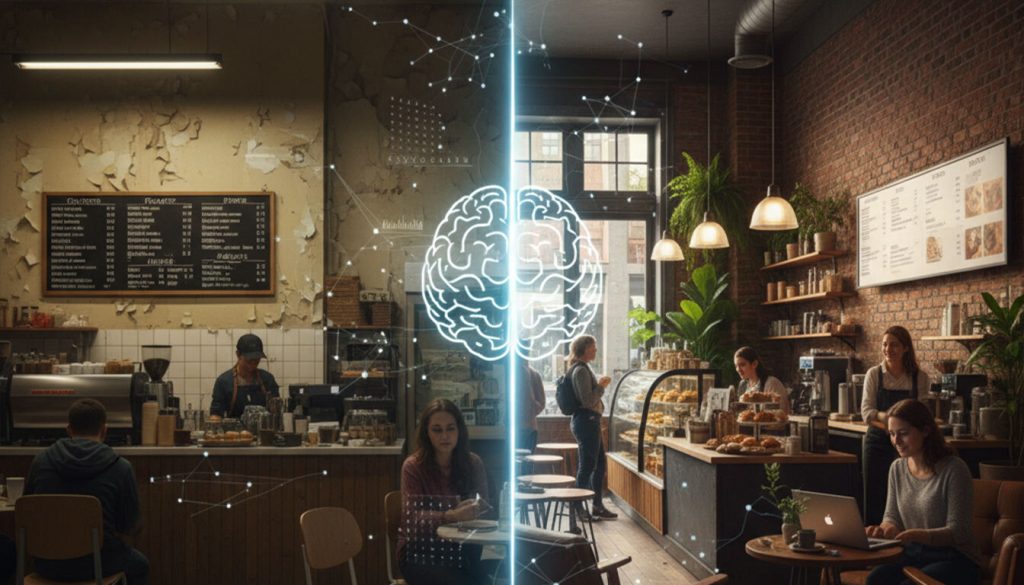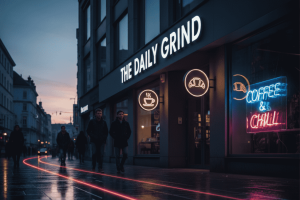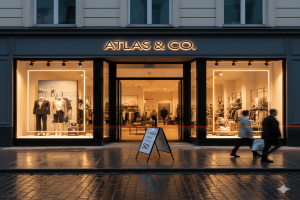The art and science of signage psychology extend far beyond attractive visuals or creative displays. Signage serves as a bridge between businesses and their audiences—conveying messages, emotions, and brand values in just a few seconds. From the moment a customer walks past a storefront or enters a retail space, signage begins to influence their behaviour subconsciously.
In an age where consumer attention spans are shorter than ever, understanding how design affects perception is not just a creative advantage—it’s a business necessity. Whether it’s the calming blue of a pharmacy sign, the energetic red of a sale banner, or the minimalist typography of a luxury boutique, every design choice speaks directly to the human mind.
This comprehensive guide delves deep into the world of signage psychology—examining how colour, typography, placement, and layout influence decision-making, brand trust, and engagement. We’ll also explore practical insights for businesses aiming to create signage that not only captures attention but also drives measurable behavioural outcomes.
Understanding the Concept of Signage Psychology
Signage psychology is the study of how visual communication and design elements—such as colour, typography, layout, and placement—affect human perception and behaviour. It explores the subtle psychological mechanisms that influence how consumers interpret, feel about, and respond to signs in their environment.
At its core, signage psychology combines principles from behavioural science, marketing, and design theory. The goal is to ensure that a sign not only delivers a message but also evokes the intended emotional and cognitive response. For instance, an urgent sale sign uses bright red tones and bold fonts to create excitement, while a corporate law firm might use muted blues and serif typography to build trust and professionalism.
From a business perspective, understanding the psychology behind signage allows brands to craft messages that resonate. A sign that aligns with human behaviour patterns is more likely to be noticed, remembered, and acted upon. Research in environmental and retail psychology supports this—showing that well-designed signage can influence time spent in a space, impulse purchases, and even brand loyalty.
Moreover, the rise of digital and interactive signage has amplified the importance of psychological design. Modern consumers expect signs to be not only visually appealing but also emotionally intelligent—communicating brand values through subtle cues and seamless user experiences.
In essence, signage psychology helps businesses transform ordinary signboards into powerful behavioural tools that guide attention, emotion, and decision-making with precision.
The Science Behind Visual Perception in Signage Psychology
To understand signage psychology, it’s crucial to explore how the human brain perceives and processes visual information. The moment someone encounters a sign—be it a storefront logo, a directional marker, or an illuminated display—their brain makes split-second judgements that influence how they feel and act.
The Power of First Impressions
Humans process visuals 60,000 times faster than text, meaning that design elements like colour, contrast, and composition register almost instantly. A sign has only a few seconds to capture attention and communicate meaning. That’s why high-contrast colour palettes, balanced layouts, and legible typography are critical. If a sign is cluttered or difficult to read, the viewer’s brain disengages almost immediately.
Gestalt Principles and Design Perception
The Gestalt principles of visual perception—proximity, similarity, continuity, closure, and figure-ground—are fundamental in signage psychology. These principles explain how people naturally organise visual elements into meaningful patterns. For instance:
- Proximity helps users associate related information (like store departments or menu items).
- Similarity ensures consistent branding through recurring shapes, colours, or fonts.
- Figure-ground balance helps distinguish important messages from background noise.
Applying these principles in signage design ensures that messages are both intuitive and cognitively efficient.
Colour and Emotion in Signage Psychology
Colour psychology plays one of the most dominant roles in signage effectiveness. Each hue evokes a specific emotional and behavioural response:
- Red triggers urgency and excitement (common in clearance sales).
- Blue conveys reliability and calmness (used by financial and legal firms).
- Green represents growth and sustainability (ideal for eco-friendly brands).
- Yellow draws attention and creates warmth (effective in hospitality or retail).
Strategically combining these colours based on brand personality and consumer intent can dramatically enhance engagement.
Cognitive Load and Readability
The best signage designs minimise cognitive load—the mental effort required to understand information. When a sign is easy to interpret, the brain rewards the viewer with a sense of satisfaction, encouraging positive brand association. This is why effective signs use clear hierarchy, concise messaging, and white space to guide the eye naturally.
Eye-Tracking and Behavioural Studies
Modern research using eye-tracking technology reveals that people view signage in predictable visual patterns, such as the “Z-pattern” or “F-pattern.” By placing the most important elements (like logos or CTAs) along these natural paths, designers can influence how the brain absorbs information.
Overall, visual perception science provides the foundation for signage psychology—bridging the gap between design aesthetics and human behaviour. When applied strategically, it transforms signs into silent yet persuasive communicators.
Emotional Triggers in Effective Signage Design
While logical design principles ensure clarity, it’s emotion that truly drives consumer engagement. In signage psychology, emotional triggers are the invisible force that guides how people respond to visual messages. Every shape, colour, and word can spark a feeling — curiosity, trust, urgency, or excitement — that ultimately influences consumer behaviour.
1. Emotional Branding Through Signage
Signage isn’t just about visibility; it’s about connection. A well-designed sign instantly conveys a brand’s tone and personality. For example, luxury brands often use minimalistic designs with monochromatic colours and serif fonts to evoke sophistication, while casual eateries may use bright hues and playful typography to communicate friendliness and approachability.
Emotional branding through signage ensures that when people see your display, they don’t just read it — they feel it. That emotion lingers, fostering familiarity and loyalty over time.
2. The Role of Trust and Safety
Trust is one of the most significant emotional responses linked to effective signage design. Signs that are professionally made, clearly readable, and consistently branded communicate credibility. On the other hand, poorly designed or outdated signage can make consumers subconsciously question a brand’s reliability or professionalism.
In environments like hospitals, airports, or financial institutions, this trust element becomes even more critical — clear, consistent, and calm visual communication helps users feel safe and assured in their surroundings.
3. The Psychology of Urgency and Action
Retail environments often use call-to-action (CTA)-driven signage that relies on urgency and scarcity triggers — words like “limited time,” “sale ends today,” or “exclusive offer.” Combined with warm colours (especially red and orange), these messages activate the amygdala, the brain’s emotional centre, prompting faster decisions.
However, in professional or high-value settings, such as property showrooms or luxury boutiques, urgency must be balanced with refinement and trustworthiness to maintain brand integrity.
4. Nostalgia and Memory Recall
Another powerful emotional trigger in signage psychology is nostalgia. Designs that echo retro aesthetics or incorporate cultural familiarity can evoke pleasant memories, enhancing brand relatability. For instance, a vintage café might use typography and imagery reminiscent of the 1950s to emotionally transport customers and create a sense of comfort and belonging.
5. The Subconscious Influence of Shape and Typography
Shapes and typefaces have psychological weight. Rounded fonts feel friendly and approachable, while sharp-edged fonts feel bold and assertive. Similarly, curved shapes promote harmony and warmth, whereas angular designs convey precision and strength.
By aligning these subtle visual elements with brand intent, designers can influence subconscious emotions, reinforcing the brand’s message without needing a single spoken word.
Emotional design in signage doesn’t just capture attention — it builds long-term attachment. The most effective signs leave viewers feeling something genuine, whether it’s trust, excitement, curiosity, or nostalgia.
Colour Psychology and Consumer Decision-Making in Signage Design
Colour is one of the most powerful tools in signage psychology. It influences perception, emotions, and decision-making faster than text or imagery. When used strategically, colours can shape how consumers interpret a message, interact with a brand, and even decide whether to make a purchase.
The Emotional Spectrum of Colours
Each colour evokes a different emotional response. Businesses can harness this psychological effect to reinforce their branding or messaging goals.
- Red: Stimulates excitement, passion, and urgency. Frequently used in sales or promotional signs to prompt quick action.
- Blue: Evokes trust, calm, and professionalism — ideal for corporate and financial signage.
- Yellow: Represents optimism and attention. It catches the eye quickly, making it great for directional or safety signage.
- Green: Symbolises balance, health, and sustainability. Often used by eco-friendly and wellness brands.
- Black and White: Convey luxury, elegance, and timelessness, often used by high-end brands.
When designers align colour choices with brand personality, the sign becomes not just visually appealing, but psychologically persuasive.
Contrast and Readability
In signage psychology, visibility is paramount. The contrast between text and background colour directly affects how easily a sign can be read and understood. High contrast (like black on white or yellow on black) improves visibility, especially in outdoor environments.
However, readability isn’t just about standing out — it’s about guiding the viewer’s attention naturally. Strategic contrast ensures that the most important information (like CTAs or brand names) grabs attention first.
Cultural Associations and Audience Sensitivity
Colour meanings can vary across cultures. For example, while red symbolises luck and prosperity in some regions, it can represent warning or danger in others. Therefore, international brands must adapt their signage colour schemes based on cultural relevance to ensure inclusivity and effectiveness.
For businesses in the UK, this often means balancing universal emotional triggers with local expectations — a skill that top signage designers master through research and testing.
The Role of Lighting in Colour Perception
Lighting conditions significantly impact how colours appear. LED signs, for example, emit light, which can intensify or alter colour perception. Designers use colour temperature and brightness calibration to maintain consistent brand tones in both natural and artificial light.
For indoor environments, softer lighting creates a more intimate and relaxed mood, while outdoor displays often use high-brightness LEDs for maximum visibility without distortion.
The Science of Colour and Consumer Behaviour
Studies show that up to 90% of snap judgments about products can be based on colour alone. When implemented correctly, colour can guide emotional responses and decision-making.
For instance:
- Restaurants often use red and orange to stimulate appetite.
- Health and wellness brands prefer green and white for calmness and purity.
- Luxury retailers use black, gold, or silver to evoke exclusivity.
Every colour decision in signage is, therefore, a branding statement — influencing how people feel, think, and act in the space around them.
Typography, Layout, and Spatial Design in Signage Psychology
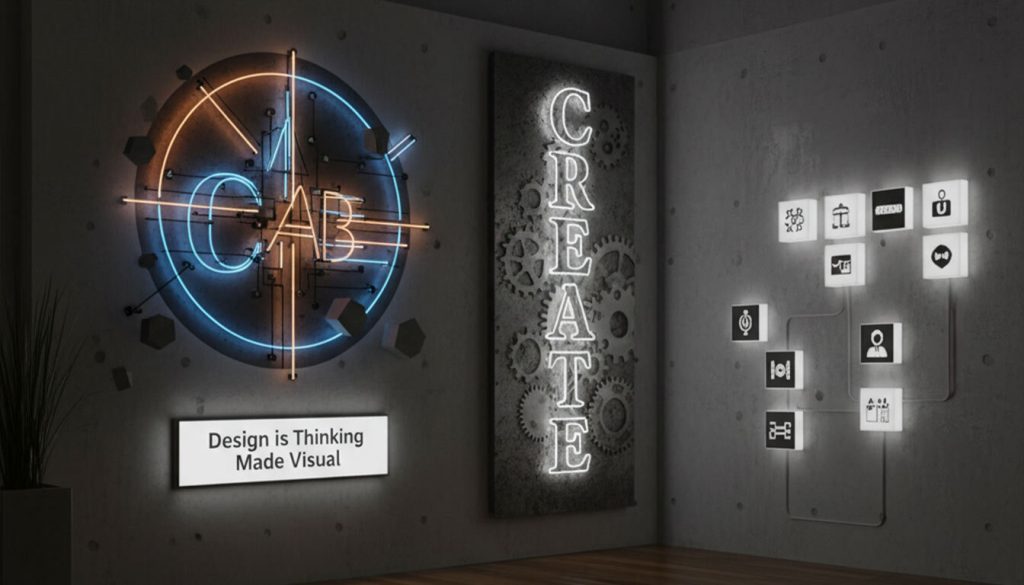
Typography and layout are often underestimated elements in signage psychology, yet they are vital in shaping how people perceive, interpret, and emotionally connect with a message. The way words are presented—through font style, size, and placement—affects how long a person looks at a sign, whether they understand its purpose, and even how they feel about the brand behind it.
1. The Role of Typography in Emotional Perception
Fonts carry personality. They communicate tone before the reader even processes the words. In signage psychology, selecting the right typeface can make the difference between a message being ignored or instantly understood.
- Serif fonts (e.g., Times New Roman) convey tradition, authority, and trust. They are commonly used by institutions, law firms, or luxury brands.
- Sans-serif fonts (e.g., Helvetica, Arial) are clean, modern, and approachable. These work well for tech companies, retailers, or casual environments.
- Script fonts add elegance or creativity but must be used sparingly for readability.
Typography in signage isn’t just about aesthetics—it’s a reflection of a brand’s character and the emotions it wants to evoke in the consumer.
2. Readability and Legibility in Design
The readability of a sign directly influences its effectiveness. People often only glance at a sign for two to three seconds. If the font is too decorative or the spacing is cramped, the message is lost.
To optimise legibility:
- Maintain ample spacing between letters and lines.
- Avoid overly intricate fonts for key information.
- Use hierarchical scaling, where important details (like headlines or offers) appear larger and bolder than supporting text.
- Keep text aligned to the natural flow of the eye (usually left-aligned for English readers).
Effective signage psychology focuses on simplifying the reading experience, allowing the viewer’s brain to process the message instantly without confusion or visual fatigue.
3. Layout and Hierarchy of Information
The visual hierarchy of a sign helps guide the viewer through the content in the intended order. A strong layout should draw the eye to the most critical message first—usually the headline, logo, or call to action.
Designers often employ techniques like:
- Size differentiation (larger elements attract more attention)
- Colour emphasis (contrasting shades to highlight key sections)
- Directional cues (arrows, shapes, or lines that subtly lead the eye)
An effective layout is intuitive; even at a glance, the viewer understands what the message is, who it’s from, and what they should do next.
4. Spatial Design and Psychological Flow
Spatial design deals with how text and visuals are arranged within a sign’s physical boundaries. In signage psychology, negative space (the empty area around design elements) is as important as the text or graphics themselves.
Proper use of space:
- Creates balance and harmony, preventing visual clutter.
- Helps highlight focal points naturally.
- Encourages the eye to move smoothly across the design.
Crowded signage tends to overwhelm the viewer, while well-balanced signage promotes clarity, trust, and engagement. The goal is to ensure the design feels breathable and deliberate, guiding rather than forcing attention.
5. Typography Consistency and Brand Identity
Consistency in typography across different signs reinforces brand recognition. A viewer who sees the same font style, colour palette, and tone across multiple locations or platforms subconsciously associates that visual identity with reliability and professionalism.
This is why global brands like Apple, McDonald’s, or Nike maintain strict typography guidelines—the font itself becomes a part of the brand’s voice. For local businesses, adopting a similar approach can strengthen brand cohesion and make signage far more memorable.
Visual Cues, Imagery, and Consumer Behaviour in Signage Psychology
In signage psychology, visuals are among the most powerful tools to shape perception and drive consumer behaviour. Humans process images 60,000 times faster than text, meaning that the visual elements of a sign often communicate a message before the viewer even reads a word. The strategic use of imagery, icons, and other visual cues can determine how long a person’s attention lingers and whether they decide to engage with a brand.
1. The Emotional Power of Imagery
Images have a direct route to human emotions. When chosen carefully, they can evoke curiosity, trust, excitement, or desire—all emotions that drive decision-making. In the context of signage psychology, the emotional impact of visuals cannot be overstated.
For example:
- People-oriented imagery builds connection and relatability. Photos of smiling faces or satisfied customers create trust and empathy.
- Product-focused visuals highlight key features and appeal to consumer needs instantly.
- Lifestyle imagery shows aspirational outcomes—such as comfort, luxury, or success—subtly encouraging the viewer to associate those feelings with the brand.
Using authentic and high-quality visuals is crucial. Poor-quality or generic stock images can have the opposite effect, signalling inauthenticity or lack of attention to detail.
2. The Role of Icons and Symbols
Icons and pictograms play a crucial role in simplifying communication, especially in environments where people move quickly or language barriers exist. The signage psychology behind icons lies in their universality—they can transcend words and instantly communicate meaning.
- Directional icons (arrows, exits, toilets) reduce cognitive load, helping users navigate spaces smoothly.
- Brand symbols (logos or custom icons) become shorthand for brand identity, increasing recognition and recall.
- Functional icons (e.g., symbols for Wi-Fi, accessibility, or payment options) reassure customers and improve user experience.
Simplicity is key—icons should be instantly recognisable, with clear outlines and strong contrast against their background.
3. Visual Hierarchy and Focal Points
The human eye naturally seeks a focal point when viewing a design. In effective signage, that focal point is intentionally placed to draw attention where it matters most. This could be a logo, a call-to-action phrase, or a striking visual element.
Designers apply visual hierarchy techniques such as:
- Contrast (light vs. dark, colour vs. monochrome)
- Proportion (large elements stand out more)
- Placement (central or top-left positioning captures attention quickly)
When the hierarchy is well-structured, viewers can process the sign’s message effortlessly, which is a key principle of signage psychology.
4. Colour Imagery and Cultural Context
While colour psychology focuses on emotional influence, colour imagery extends that understanding into visual storytelling. Different colours can signify various cultural meanings, and in signage design, these nuances must be respected—especially for international or diverse audiences.
For example:
- In the UK, green often signifies eco-friendliness or safety.
- Red can represent excitement, urgency, or even warnings, depending on the context.
- Blue communicates trust and professionalism, widely used in corporate environments.
In signage psychology, designers blend colour and imagery to evoke emotions while ensuring clarity and cultural sensitivity.
5. Movement, Light, and Interactive Elements
Modern signage psychology increasingly involves movement and interactivity—especially through digital displays and LED technologies. Motion naturally draws attention, triggering the brain’s alert system. However, it must be used with purpose.
Examples include:
- Animated digital signs in retail spaces showcasing limited-time offers.
- LED transitions that subtly change colour or intensity to maintain viewer engagement.
- Interactive touchscreens that invite customers to explore options or learn more about products.
While these innovations can dramatically enhance engagement, overuse can lead to visual fatigue or distraction. The key is balance—motion should complement, not overpower, the message.
6. Consistency Across All Visual Touchpoints
To strengthen brand recognition, the imagery, icons, and colours used in signage must align with other marketing materials—such as websites, brochures, and social media content. Consistency reinforces memory. When consumers repeatedly encounter similar visuals in different settings, they subconsciously associate those images with reliability and quality.
In signage psychology, this consistency helps establish trust continuity—where customers know what to expect each time they interact with the brand visually.
Spatial Context and Environmental Psychology in Signage
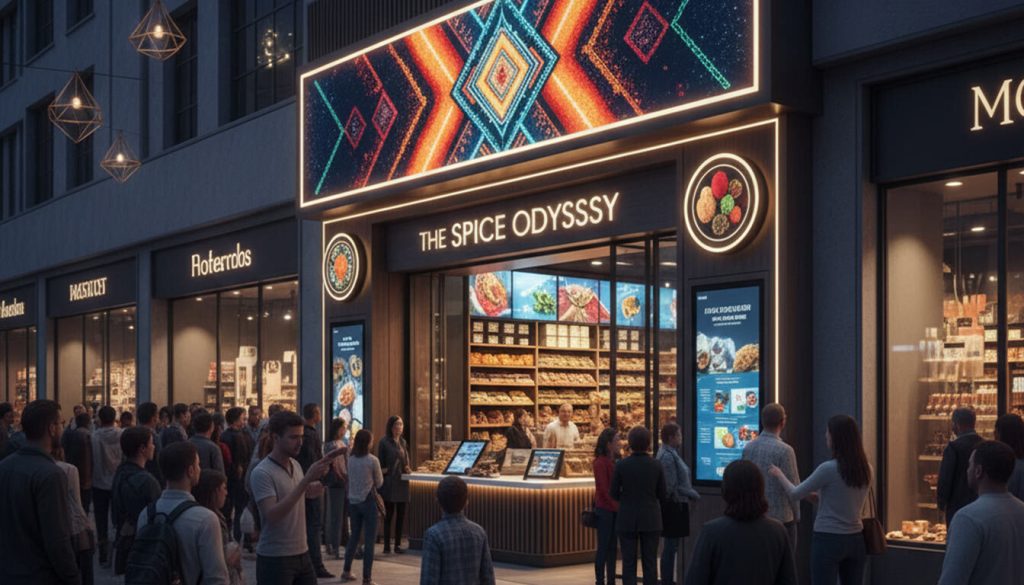
In signage psychology, the environment where a sign is placed plays as significant a role as the design itself. The same sign can perform exceptionally well in one setting and fail to capture attention in another simply because of lighting, placement, or competing visual stimuli. Understanding spatial context and how people interact with their surroundings is key to creating signs that not only stand out but also blend naturally within the viewer’s line of sight and behavioural patterns.
The Role of Environmental Psychology in Signage Design
Environmental psychology examines how physical spaces influence human behaviour, mood, and decisions. When applied to signage, this concept helps designers anticipate how people move, look, and respond in various environments. For example, a sign placed at eye level in a high-traffic retail corridor will naturally perform better than one positioned too high or low.
From a signage psychology standpoint, effective signs align with the “path of least resistance”—meaning they are designed and positioned to be seen effortlessly, without requiring conscious searching or head movement. Signs that fit intuitively into the environment enhance user experience and encourage trust in the brand.
Strategic Placement and Viewing Angles
The placement of a sign determines its visibility, readability, and impact. The ideal viewing angle depends on the type of space, the distance of the audience, and how fast they are moving.
For example:
- Outdoor signage should be placed perpendicular to the flow of traffic for maximum exposure.
- Retail signage should align with natural sightlines—eye-level for standing customers and slightly downward for seated areas.
- Directional signs (like wayfinding systems) must be visible from multiple vantage points to aid navigation.
Signage psychology also considers visual competition—too many signs in one area create clutter, causing each message to lose impact. A single, well-placed sign can outperform several smaller ones fighting for attention.
Lighting and Visibility Conditions
Light plays a dual role in signage design—it enhances visibility and sets emotional tone. Inadequate or poorly positioned lighting can make even the most well-designed sign ineffective. On the other hand, strategically illuminated signs command attention, communicate professionalism, and enhance brand perception.
Types of lighting and their influence on signage psychology:
- Backlit signage provides depth and a premium aesthetic, commonly used for corporate and retail environments.
- LED edge lighting adds vibrancy and ensures visibility at night or in dim spaces.
- Natural lighting considerations—designers must anticipate glare, shadows, and reflections that might obscure visibility during certain hours.
By harmonising artificial and natural light, businesses can ensure consistent readability and brand presence day and night.
Proximity and Wayfinding Efficiency
Spatial planning is crucial in environments where multiple signs serve different purposes—such as airports, shopping centres, or hospitals. Signage psychology suggests that people rely on predictable visual cues to navigate unfamiliar spaces efficiently.
Good wayfinding signage:
- Follows a logical progression from entry points to destinations.
- Uses consistent colours, icons, and typography.
- Avoids redundant or conflicting directions.
By understanding how people perceive and move through space, designers can create signage systems that feel intuitive, reducing confusion and cognitive strain.
Environmental Integration and Material Choices
The material and finish of signage must reflect both the brand’s identity and its surroundings. For instance:
- Wood or natural finishes create warmth and authenticity, ideal for cafés, wellness spaces, or eco-friendly brands.
- Metallic and glass finishes convey sophistication and modernity, suitable for offices and corporate environments.
- Textured or illuminated signs can enhance visual engagement in contemporary retail or entertainment settings.
In signage psychology, congruence between materials and the physical environment fosters harmony and trust. When signage feels like an organic part of the space rather than an afterthought, it strengthens both brand coherence and visitor satisfaction.
Ambient Elements and Sensory Impact
Beyond visual design, environmental cues such as sound, temperature, and scent can subtly enhance or hinder the impact of signage. For instance, a softly illuminated sign in a calm, quiet setting (like a spa) contributes to a sense of serenity, while bold LED signage with upbeat lighting fits the high-energy environment of a gym or retail outlet.
By acknowledging these sensory factors, signage psychology extends beyond design—it becomes part of a multisensory experience that shapes how people perceive the entire brand environment.
The Science and Art of Signage Psychology
The signage psychology behind every effective design goes far beyond colours and fonts—it’s about understanding human behaviour, emotion, and cognition. A well-designed sign doesn’t just convey information; it influences decisions, evokes feelings, and strengthens brand perception. Whether used outdoors to attract passers-by or indoors to reinforce brand presence, every element—typography, imagery, placement, lighting, and even material—plays a deliberate psychological role.
Personalisation adds another layer to this psychology. When signage is tailored to specific audiences—through custom displays, local references, or brand-aligned visuals—it creates emotional resonance and builds trust. This is especially powerful in retail environments, where personalised signage can turn casual browsers into loyal customers.
How Digital Signage Can Help Build Brand Loyalty in Retail
Successful signage connects on three levels:
- Visually, it catches attention instantly.
- Emotionally, it resonates with the viewer’s values or desires.
- Cognitively, it’s easy to read, remember, and act upon.
By understanding how people subconsciously process visual information, businesses can design signs that not only attract attention but also build trust and loyalty. The strongest signs are those that blend creativity with strategy—where design decisions are guided by insight, not instinct.
For businesses looking to enhance their visibility and engagement, embracing signage psychology means transforming every display into an active, persuasive communication tool. From the colour of your brand name to the lighting of your storefront, every choice can influence how customers perceive and remember you.
Unleash the Power of Smart Sign Design with Msigns
At Msigns, we understand that great signage isn’t just about design—it’s about psychology, strategy, and storytelling. Our team combines design expertise with behavioural insight to create signage solutions that truly connect with your audience.
Whether you need indoor branding, LED displays, or outdoor promotional signage, Msigns ensures every detail reflects your brand’s personality and purpose.
Contact Msigns today to explore signage solutions that turn first impressions into lasting engagement.


